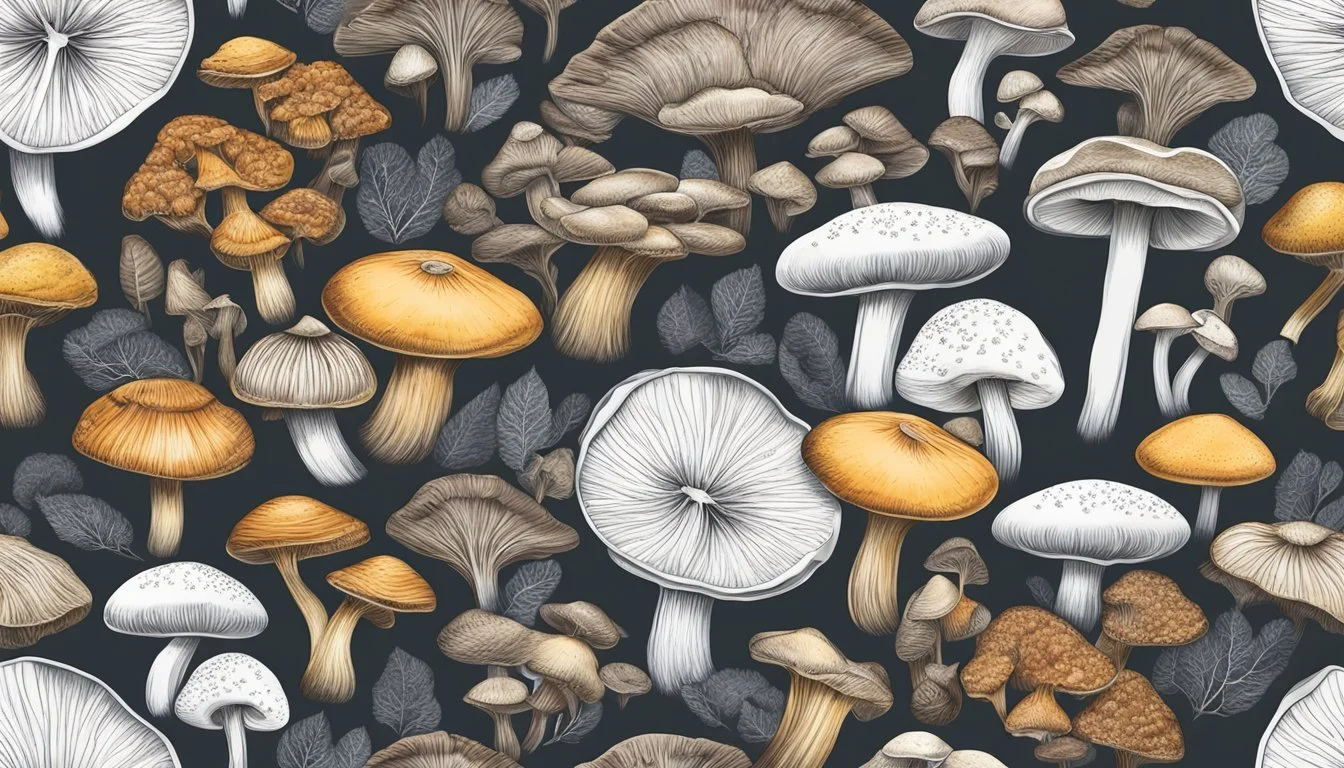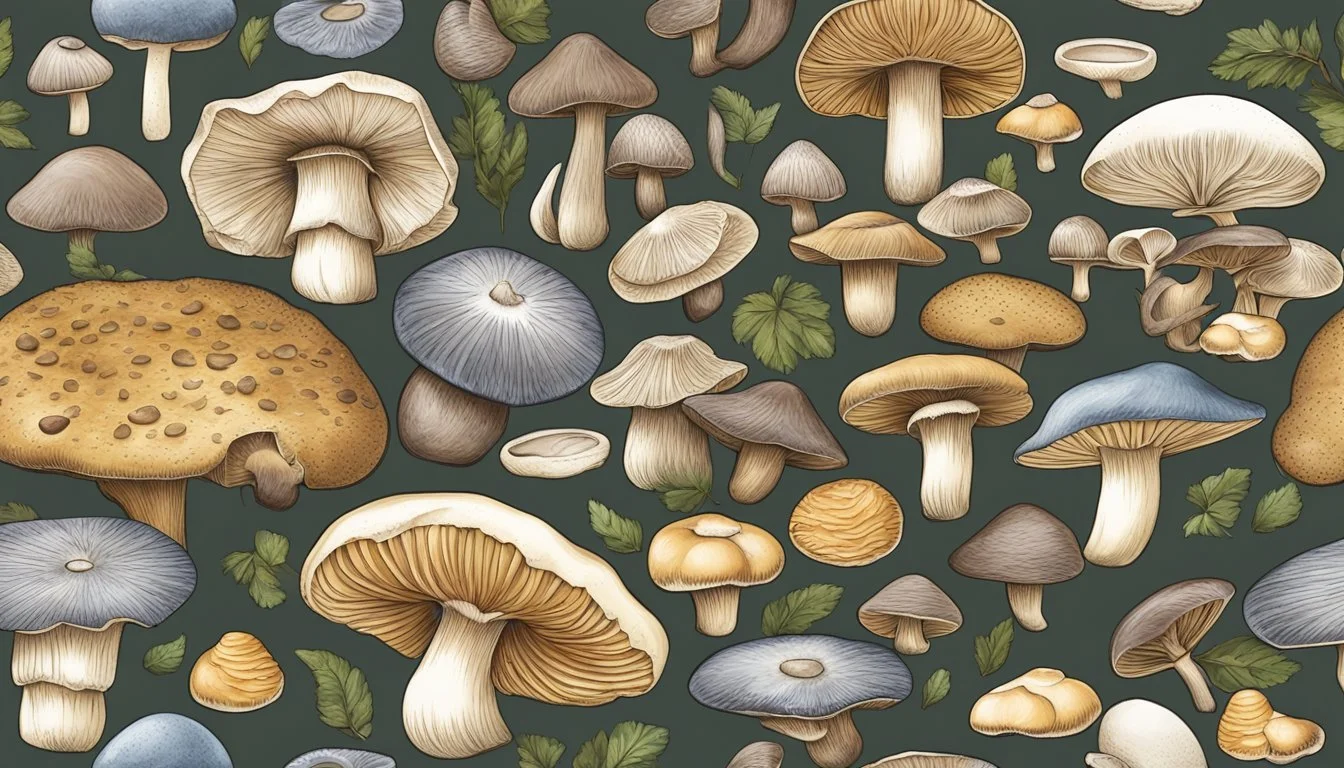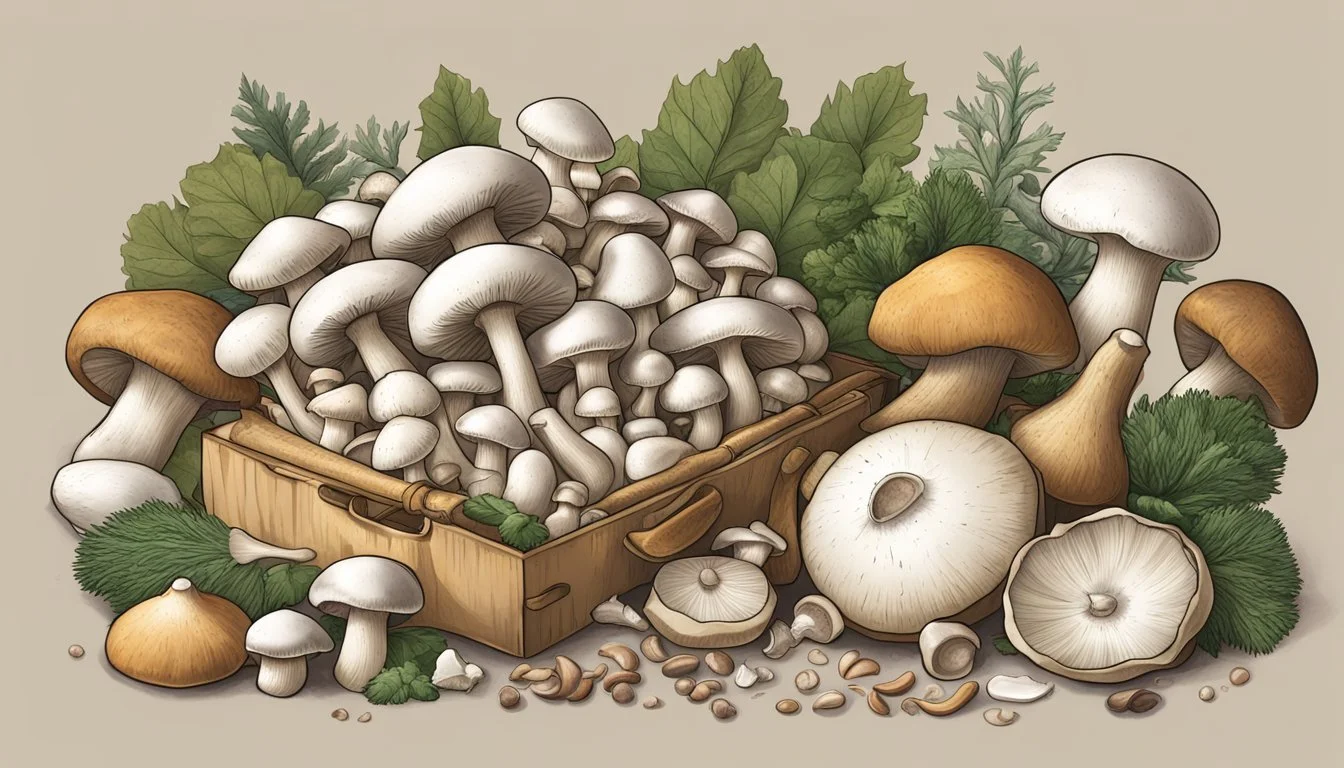Frozen vs Fresh Mushrooms: A Fungi Face-Off
Mushrooms are a versatile and flavorful ingredient enjoyed by many. The debate between frozen and fresh mushrooms often arises when considering convenience, taste, and nutritional value.
Frozen mushrooms can be a suitable alternative to fresh ones, especially for cooked dishes like soups, stews, and sauces. They offer extended shelf life and are pre-cleaned, sliced, and ready to use. Fresh mushrooms, on the other hand, provide a firmer texture and are ideal for salads or dishes where texture is crucial.
Both options have their merits. Fresh mushrooms excel in raw applications, while frozen mushrooms shine in cooked recipes. The choice between frozen and fresh ultimately depends on the specific dish, personal preference, and storage capabilities.
Understanding Frozen Mushrooms
Frozen mushrooms offer convenience and extended shelf life while maintaining nutritional value. The freezing process affects texture and flavor, making proper storage techniques essential for optimal quality.
Freezing Process and Methods
Mushrooms can be frozen using several methods. The tray freeze technique involves placing sliced mushrooms in a single layer on a baking sheet before transferring to freezer-safe bags. This prevents clumping and makes portioning easier.
Another method is sautéing mushrooms briefly before freezing. This helps preserve texture and concentrate flavors. After cooking, mushrooms are cooled and packed in airtight containers or freezer bags.
Some prefer freezing raw mushrooms directly in freezer-safe bags. While quick, this may lead to more texture changes upon thawing.
Impact on Flavor and Texture
Freezing alters mushroom texture due to ice crystal formation within cells. Upon thawing, frozen mushrooms become softer and release more liquid compared to fresh ones.
Flavor remains largely intact, though some subtle notes may be lost. Frozen mushrooms work well in cooked dishes like soups, stews, and sauces where texture changes are less noticeable.
For raw applications like salads, fresh mushrooms are generally preferred. However, thawed frozen mushrooms can still add flavor to cold dishes when finely chopped or sliced.
Proper Storage Techniques
To maintain quality, store frozen mushrooms at 0°F (-18°C) or below. Use airtight, freezer-safe containers or heavy-duty freezer bags to prevent freezer burn.
Remove as much air as possible from bags before sealing. Label containers with freeze date and use within 9-12 months for best quality.
When ready to use, frozen mushrooms can be added directly to hot dishes without thawing. For other uses, thaw in the refrigerator overnight or under cold running water.
Exploring Fresh Mushrooms
Fresh mushrooms offer a unique flavor and texture experience. Their versatility in cooking and nutritional benefits make them a popular choice for many dishes.
Quality and Selection
Look for firm, smooth mushrooms with unblemished caps. Avoid specimens with dark spots, slime, or wrinkled surfaces. White button mushrooms should have tightly closed caps, while mature portobello mushrooms can have open gills.
Fresh mushrooms typically have a shelf life of 5-7 days when stored properly. Keep them in a paper bag or breathable container in the refrigerator. Avoid plastic bags, which can trap moisture and accelerate spoilage.
Choose mushrooms with a fresh, earthy scent. Strong or unpleasant odors indicate decay. Gently squeeze the mushrooms - they should feel firm and springy, not slimy or mushy.
Cleaning and Preparing
Clean fresh mushrooms just before use to prevent excess moisture absorption. Gently brush off visible dirt and debris with a soft brush or damp paper towel. Avoid soaking mushrooms in water, as they act like sponges and can become waterlogged.
For stubborn dirt, quickly rinse mushrooms under cool running water and pat dry immediately. Trim off any tough stems or discolored parts. Slice or chop mushrooms according to recipe requirements.
Store cleaned mushrooms in a paper towel-lined container in the refrigerator. Use within 1-2 days for optimal freshness and flavor. Fresh mushrooms can be sautéed, grilled, roasted, or eaten raw in salads.
Comparing Nutrition and Taste
Fresh and frozen mushrooms differ in their nutritional content and flavor profiles. These differences can impact their use in cooking and potential health benefits.
Nutritional Value
Fresh mushrooms generally contain more nutrients than their frozen counterparts. They are rich in B vitamins, particularly riboflavin and niacin. Fresh mushrooms also provide a good source of antioxidants, which help protect cells from damage.
Frozen mushrooms retain most of their nutrients, but some water-soluble vitamins may be lost during the freezing process. Both fresh and frozen varieties are low in calories, with about 20-30 calories per 100 grams.
Fresh mushrooms typically have higher levels of potassium and selenium. They also contain more fiber, which aids digestion and promotes feelings of fullness.
Taste Profiles
Fresh mushrooms offer a more pronounced umami flavor and firmer texture. Their earthy taste is more intense, making them ideal for dishes where mushroom flavor is central.
Frozen mushrooms have a slightly muted taste compared to fresh ones. The freezing process can alter their texture, making them softer when thawed and cooked.
Fresh mushrooms provide a satisfying crunch in raw preparations like salads. Frozen mushrooms are better suited for cooked dishes where texture changes are less noticeable.
The choice between fresh and frozen often depends on the specific recipe and desired outcome. Fresh mushrooms excel in quick-cooking methods, while frozen ones work well in soups and stews.
Cooking with Mushrooms
Mushrooms offer versatility in the kitchen, adapting well to various cooking techniques. Their unique texture and flavor make them a valuable ingredient in many dishes.
Techniques for Sautéing
Sautéing is a popular method for cooking mushrooms. Heat a skillet over medium-high heat and add olive oil. Once hot, add sliced mushrooms in a single layer. Cook for 3-4 minutes without stirring to allow browning.
Stir and continue cooking for another 3-5 minutes until golden. Season with salt and pepper to taste. For extra flavor, add minced garlic or herbs in the last minute of cooking.
Sautéed mushrooms work well as a side dish or topping for steaks, burgers, or pasta.
Baking and Steaming Applications
Baking mushrooms creates a concentrated flavor and meaty texture. Preheat the oven to 400°F (200°C). Toss mushrooms with olive oil, salt, and pepper. Spread on a baking sheet and roast for 20-25 minutes, stirring halfway through.
Steaming is a healthier option that preserves nutrients. Place mushrooms in a steamer basket over simmering water. Steam for 5-7 minutes until tender.
Baked mushrooms are excellent in casseroles or as a pizza topping. Steamed mushrooms work well in salads or as a light side dish.
Incorporating Mushrooms into Recipes
Mushrooms enhance many dishes with their umami flavor. In stir-fries, add sliced mushrooms towards the end of cooking to prevent overcooking. For soups and stews, sauté mushrooms before adding to the pot for deeper flavor.
Stuffed mushrooms make a great appetizer. Remove stems, fill caps with a mixture of breadcrumbs, cheese, and herbs, then bake until golden.
Finely chopped mushrooms can replace or extend ground meat in burgers or meatballs, adding moisture and reducing calories. They also make a flavorful addition to omelets, quiches, and risottos.
Preparing Mushrooms for Freezing
Proper preparation is key to preserving mushrooms' flavor and texture when freezing. The process involves cleaning, blanching, and packaging to maintain quality.
How to Blanch Mushrooms
Clean mushrooms by gently brushing off dirt or rinsing quickly under cold water. Slice or quarter larger mushrooms. Bring a pot of water to a boil and prepare an ice bath. Place mushrooms in a steamer basket and steam for 3-5 minutes. Immediately transfer to the ice bath to stop cooking. Pat dry with a clean towel.
Spread blanched mushrooms on a parchment-lined baking sheet in a single layer. Place in the freezer for several hours until completely frozen. This flash-freezing method prevents clumping.
Freezing Cooked vs Raw Mushrooms
Cooked mushrooms often freeze better than raw ones. Sauté sliced mushrooms with a pinch of salt for 5 minutes. Add Italian dressing and cook for 4 more minutes. Cool before packaging.
For raw mushrooms, clean and slice as desired. Freeze on a baking sheet, then transfer to freezer bags. Remove excess air before sealing.
Both methods work, but cooked mushrooms typically retain better texture. Use within 6-8 months for best quality. Label containers with the freezing date.
Thawing and Using Frozen Mushrooms
Proper thawing and usage techniques are crucial for maintaining the quality of frozen mushrooms. These methods help preserve texture and flavor while ensuring food safety.
Best Practices
Thaw frozen mushrooms in the refrigerator for 6-8 hours or overnight. This gradual process helps maintain their texture. For quicker thawing, place mushrooms in a sealed plastic bag and submerge in cold water for 30 minutes. Change the water every 10 minutes to ensure even thawing.
Once thawed, pat mushrooms dry with paper towels to remove excess moisture. Use thawed mushrooms within 24 hours for best quality. They work well in cooked dishes like stir-fries, soups, and sauces.
For sautéing, heat oil in a pan over medium-high heat. Add thawed mushrooms and cook for 5-7 minutes until golden brown. Season with salt and pepper to taste.
Avoiding Common Pitfalls
Never thaw mushrooms at room temperature, as this can lead to bacterial growth. Avoid using a microwave to thaw, as it can make mushrooms mushy and unevenly heated.
Don't refreeze thawed mushrooms, as this can compromise texture and flavor. Always check the expiration date on frozen mushrooms and use them within 6-8 months for optimal quality.
When cooking, avoid overcrowding the pan. This can cause mushrooms to steam instead of brown, resulting in a less desirable texture. Add thawed mushrooms to dishes towards the end of cooking to prevent them from becoming too soft.
Be cautious when using frozen mushrooms in raw applications like salads, as their texture may be softer than fresh mushrooms.
Types and Uses of Mushrooms
Mushrooms come in diverse varieties, each with unique flavors and culinary applications. From earthy portobellos to delicate enokis, these fungi enhance dishes with their umami richness and versatile textures.
Different Types and Their Characteristics
Button mushrooms are mild and widely available, perfect for everyday cooking. Crimini mushrooms offer a deeper flavor, ideal for sautéing or grilling. Shiitake mushrooms have a meaty texture and intense umami taste, excellent in Asian cuisines. Oyster mushrooms provide a delicate flavor and velvety texture, great for stir-fries.
Portobello mushrooms are large and meaty, often used as vegetarian burger alternatives. Enoki mushrooms are thin and crisp, commonly added to soups and salads. Porcini mushrooms have a strong, nutty flavor, prized in Italian dishes. Chanterelles are golden and fruity, complementing eggs and cream sauces.
Selecting Mushrooms for Various Dishes
For pasta dishes, cremini or shiitake mushrooms add depth and texture. Salads benefit from raw button or enoki mushrooms for crunch. Soups gain richness from dried porcini or fresh shiitake mushrooms. Casseroles and rice dishes pair well with a mix of button and portobello mushrooms.
Sauces thicken beautifully with finely chopped cremini or shiitake mushrooms. Grilled portobello caps make excellent meat substitutes in sandwiches. Stir-fries benefit from oyster or shiitake mushrooms' quick cooking time. Risottos shine with porcini or chanterelle mushrooms' intense flavors.
When selecting mushrooms, look for firm, dry specimens without blemishes. Fresh mushrooms should have a pleasant earthy smell. For dried mushrooms, choose those with vibrant colors and no signs of moisture.
Maximizing Shelf Life and Reducing Food Waste
Proper storage techniques and creative cooking methods can significantly extend mushroom shelf life and minimize waste. These strategies help maintain quality while maximizing usage of this versatile ingredient.
Refrigeration and Expiration
Store fresh mushrooms in the refrigerator at 32-38°F (0-3°C) with 85-95% humidity. Place whole mushrooms in a paper bag or unsealed container to allow air circulation. Avoid plastic bags, which trap moisture and accelerate spoilage.
Whole mushrooms typically last 7-10 days when refrigerated properly. Sliced mushrooms have a shorter shelf life of about 5-7 days. Check mushrooms regularly for signs of spoilage like sliminess, dark spots, or strong odors.
Clean mushrooms just before use to prevent excess moisture. Brush off dirt with a soft brush or damp paper towel. Avoid soaking, as mushrooms absorb water quickly.
Freezing extends shelf life to 9-12 months. Blanch mushrooms briefly, then freeze in a single layer on a tray before transferring to freezer bags.
Creative Ways to Use Mushrooms Before Spoilage
Sauté mushrooms and freeze in portion sizes for quick meal additions. Use in soups, stir-fries, or pasta dishes.
Blend cooked mushrooms into sauces or dips for added flavor and nutrition. Mix with ground meat to create flavorful, lower-calorie burgers or meatballs.
Pickle mushrooms to extend shelf life and add tangy flavor to salads or antipasto platters. Use a simple brine of vinegar, water, salt, and spices.
Dehydrate sliced mushrooms for long-term storage. Rehydrate in warm water or broth when ready to use in recipes.
Create mushroom powder by grinding dried mushrooms. Use as a seasoning or to boost umami flavor in soups and sauces.
Incorporate mushrooms into egg dishes like frittatas or omelets. Add to quiches or savory tarts for a delicious way to use up extras.
Specialty Uses and Techniques
Frozen and fresh mushrooms offer unique advantages for various culinary applications. Their distinct properties make them suitable for different cooking methods and dishes.
Mushrooms in Soups and Sauces
Frozen mushrooms excel in soups and sauces. Their softer texture allows them to blend seamlessly into liquid-based dishes. Add frozen mushrooms directly to simmering soups or sauces without thawing for best results.
For cream-based soups, sauté thawed mushrooms in a bit of fat before adding to enhance flavor. In gravies, frozen mushrooms can be stirred in during the final minutes of cooking.
For clear broths, fresh mushrooms are preferable. Their firmer texture holds up better and provides a more appealing appearance. Slice fresh mushrooms thinly and add them near the end of cooking to preserve their texture.
Elevating Pasta and Rice Dishes
Both frozen and fresh mushrooms can elevate pasta and rice dishes. For quick weeknight meals, frozen mushrooms are convenient additions to pasta sauces.
Fresh mushrooms shine in risottos and pilaf. Sauté them in butter or oil before adding rice for maximum flavor infusion. In stroganoff, fresh mushrooms maintain their shape and provide textural contrast.
For cold pasta salads, blanch fresh mushrooms briefly in boiling water with a splash of lemon juice. Drain in a colander and cool before adding to the salad to prevent discoloration.
Creating Mushroom-Based Condiments
Mushroom-based condiments benefit from the concentrated flavor of dried mushrooms. Rehydrate dried mushrooms in hot water, then blend with fresh mushrooms for a rich, umami-packed spread.
For mushroom pesto, use a mix of fresh and frozen mushrooms. Pulse in a food processor with herbs, nuts, and oil for a versatile condiment. This pesto can be frozen in ice cube trays for easy portioning.
Pickled mushrooms are best made with fresh varieties. Their firm texture holds up well during the pickling process. Use small, whole mushrooms or quarter larger ones for even pickling.





